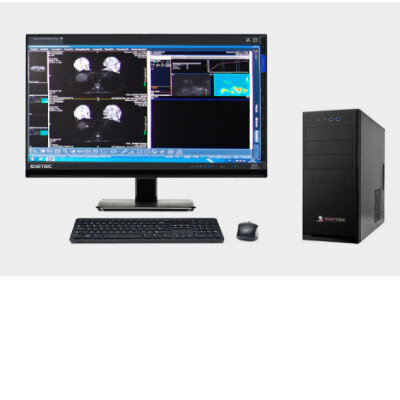Gyroscopic Radiosurgery Platform Ablates Brain Tumors
|
By MedImaging International staff writers Posted on 11 Feb 2019 |

Image: The ZAP-X gyroscopic radiosurgery platform (Photo courtesy of ZAP Surgical Systems).
A novel radiotherapy (RT) platform delivers high-dose stereotactic radiosurgery (SRS) to non-invasively ablate brain tumors and other select intracranial conditions.
The ZAP Surgical Systems (San Carlos, CA, USA) ZAP-X Gyroscopic Radiosurgery system is a self-contained, self-shielded therapeutic RT device dedicated to the treatment of benign and malignant intracranial and cervical spine lesions, in some cases as inferior as C7. ZAP-X is powered by a 2.7 megavolt S-band linear accelerator (LINAC) which serves as the source of the therapeutic radiation, mounted within a combination of yoked gimbals, each of which accurately rotates around the common isocenter, much like a large gyroscope.
Accurate beam positioning is accomplished by the LINAC beam crossfiring from 2π steradians of solid angle, and precise movements of the robotic patient table. Most components needed to produce the beam, such as the radiofrequency power source, waveguide system, and beam triggering electronics, as well as significant radiation shielding, are mounted on or integrated into the rotating patient treatment chamber sphere. The patient is supported on the moveable treatment table, which extends outside the treatment sphere, but which itself is also enclosed by additional radiation shielding during SRS.
The Zap-X accomplishes precise three-dimensional (3D) patient registration by means of an integrated planar kilovolt (kV) imaging system that also rotates around the patient’s head. Pairs of non-coaxial x-ray images and image-to-image correlations are used to determine the location of the patient’s anatomy in relation to the machine isocenter, both prior to and during SRS treatment. A fully integrated dosimetry validation system monitors and verifies delivered RT dosage in real-time. Finally, ZAP-X incorporates a unique self-shielded design that typically eliminates the need for costly radiation vaults.
“After almost a decade of effort, we're incredibly proud of what the ZAP-X can mean to cancer patients,” said professor of neurosurgery John Adler, MD, CEO of ZAP Surgical Systems. “Using leading-edge technology, we've removed many historical limitations to the wider availability of SRS, and in doing so, seek to establish a new standard in precision radiation medicine.”
SRS is a non-surgical radiation therapy used to treat functional abnormalities and small tumors of the brain. When SRS is used to treat body tumors, it is called stereotactic body radiotherapy (SBRT). Both SRS and SBRT are an image-guided radiation therapy (IGRT), relying on 3D imaging and localization techniques, immobilization systems for precise patient position during therapy, and highly focused gamma ray or x-ray beams that converge on the tumor.
Related Links:
ZAP Surgical Systems
The ZAP Surgical Systems (San Carlos, CA, USA) ZAP-X Gyroscopic Radiosurgery system is a self-contained, self-shielded therapeutic RT device dedicated to the treatment of benign and malignant intracranial and cervical spine lesions, in some cases as inferior as C7. ZAP-X is powered by a 2.7 megavolt S-band linear accelerator (LINAC) which serves as the source of the therapeutic radiation, mounted within a combination of yoked gimbals, each of which accurately rotates around the common isocenter, much like a large gyroscope.
Accurate beam positioning is accomplished by the LINAC beam crossfiring from 2π steradians of solid angle, and precise movements of the robotic patient table. Most components needed to produce the beam, such as the radiofrequency power source, waveguide system, and beam triggering electronics, as well as significant radiation shielding, are mounted on or integrated into the rotating patient treatment chamber sphere. The patient is supported on the moveable treatment table, which extends outside the treatment sphere, but which itself is also enclosed by additional radiation shielding during SRS.
The Zap-X accomplishes precise three-dimensional (3D) patient registration by means of an integrated planar kilovolt (kV) imaging system that also rotates around the patient’s head. Pairs of non-coaxial x-ray images and image-to-image correlations are used to determine the location of the patient’s anatomy in relation to the machine isocenter, both prior to and during SRS treatment. A fully integrated dosimetry validation system monitors and verifies delivered RT dosage in real-time. Finally, ZAP-X incorporates a unique self-shielded design that typically eliminates the need for costly radiation vaults.
“After almost a decade of effort, we're incredibly proud of what the ZAP-X can mean to cancer patients,” said professor of neurosurgery John Adler, MD, CEO of ZAP Surgical Systems. “Using leading-edge technology, we've removed many historical limitations to the wider availability of SRS, and in doing so, seek to establish a new standard in precision radiation medicine.”
SRS is a non-surgical radiation therapy used to treat functional abnormalities and small tumors of the brain. When SRS is used to treat body tumors, it is called stereotactic body radiotherapy (SBRT). Both SRS and SBRT are an image-guided radiation therapy (IGRT), relying on 3D imaging and localization techniques, immobilization systems for precise patient position during therapy, and highly focused gamma ray or x-ray beams that converge on the tumor.
Related Links:
ZAP Surgical Systems
Latest Nuclear Medicine News
- New SPECT/CT Technique Could Change Imaging Practices and Increase Patient Access
- New Radiotheranostic System Detects and Treats Ovarian Cancer Noninvasively
- AI System Automatically and Reliably Detects Cardiac Amyloidosis Using Scintigraphy Imaging
- Early 30-Minute Dynamic FDG-PET Acquisition Could Halve Lung Scan Times
- New Method for Triggering and Imaging Seizures to Help Guide Epilepsy Surgery
- Radioguided Surgery Accurately Detects and Removes Metastatic Lymph Nodes in Prostate Cancer Patients
- New PET Tracer Detects Inflammatory Arthritis Before Symptoms Appear
- Novel PET Tracer Enhances Lesion Detection in Medullary Thyroid Cancer
- Targeted Therapy Delivers Radiation Directly To Cells in Hard-To-Treat Cancers
- New PET Tracer Noninvasively Identifies Cancer Gene Mutation for More Precise Diagnosis
- Algorithm Predicts Prostate Cancer Recurrence in Patients Treated by Radiation Therapy
- Novel PET Imaging Tracer Noninvasively Identifies Cancer Gene Mutation for More Precise Diagnosis
- Ultrafast Laser Technology to Improve Cancer Treatment
- Low-Dose Radiation Therapy Demonstrates Potential for Treatment of Heart Failure
- New PET Radiotracer Aids Early, Noninvasive Detection of Inflammatory Bowel Disease
- Combining Amino Acid PET and MRI Imaging to Help Treat Aggressive Brain Tumors
Channels
Radiography
view channel
Novel Breast Imaging System Proves As Effective As Mammography
Breast cancer remains the most frequently diagnosed cancer among women. It is projected that one in eight women will be diagnosed with breast cancer during her lifetime, and one in 42 women who turn 50... Read more
AI Assistance Improves Breast-Cancer Screening by Reducing False Positives
Radiologists typically detect one case of cancer for every 200 mammograms reviewed. However, these evaluations often result in false positives, leading to unnecessary patient recalls for additional testing,... Read moreMRI
view channel
PET/MRI Improves Diagnostic Accuracy for Prostate Cancer Patients
The Prostate Imaging Reporting and Data System (PI-RADS) is a five-point scale to assess potential prostate cancer in MR images. PI-RADS category 3 which offers an unclear suggestion of clinically significant... Read more
Next Generation MR-Guided Focused Ultrasound Ushers In Future of Incisionless Neurosurgery
Essential tremor, often called familial, idiopathic, or benign tremor, leads to uncontrollable shaking that significantly affects a person’s life. When traditional medications do not alleviate symptoms,... Read more
Two-Part MRI Scan Detects Prostate Cancer More Quickly without Compromising Diagnostic Quality
Prostate cancer ranks as the most prevalent cancer among men. Over the last decade, the introduction of MRI scans has significantly transformed the diagnosis process, marking the most substantial advancement... Read moreUltrasound
view channel
Deep Learning Advances Super-Resolution Ultrasound Imaging
Ultrasound localization microscopy (ULM) is an advanced imaging technique that offers high-resolution visualization of microvascular structures. It employs microbubbles, FDA-approved contrast agents, injected... Read more
Novel Ultrasound-Launched Targeted Nanoparticle Eliminates Biofilm and Bacterial Infection
Biofilms, formed by bacteria aggregating into dense communities for protection against harsh environmental conditions, are a significant contributor to various infectious diseases. Biofilms frequently... Read moreGeneral/Advanced Imaging
view channel
New AI Method Captures Uncertainty in Medical Images
In the field of biomedicine, segmentation is the process of annotating pixels from an important structure in medical images, such as organs or cells. Artificial Intelligence (AI) models are utilized to... Read more.jpg)
CT Coronary Angiography Reduces Need for Invasive Tests to Diagnose Coronary Artery Disease
Coronary artery disease (CAD), one of the leading causes of death worldwide, involves the narrowing of coronary arteries due to atherosclerosis, resulting in insufficient blood flow to the heart muscle.... Read more
Novel Blood Test Could Reduce Need for PET Imaging of Patients with Alzheimer’s
Alzheimer's disease (AD), a condition marked by cognitive decline and the presence of beta-amyloid (Aβ) plaques and neurofibrillary tangles in the brain, poses diagnostic challenges. Amyloid positron emission... Read more.jpg)
CT-Based Deep Learning Algorithm Accurately Differentiates Benign From Malignant Vertebral Fractures
The rise in the aging population is expected to result in a corresponding increase in the prevalence of vertebral fractures which can cause back pain or neurologic compromise, leading to impaired function... Read moreImaging IT
view channel
New Google Cloud Medical Imaging Suite Makes Imaging Healthcare Data More Accessible
Medical imaging is a critical tool used to diagnose patients, and there are billions of medical images scanned globally each year. Imaging data accounts for about 90% of all healthcare data1 and, until... Read more
Global AI in Medical Diagnostics Market to Be Driven by Demand for Image Recognition in Radiology
The global artificial intelligence (AI) in medical diagnostics market is expanding with early disease detection being one of its key applications and image recognition becoming a compelling consumer proposition... Read moreIndustry News
view channel
Bayer and Google Partner on New AI Product for Radiologists
Medical imaging data comprises around 90% of all healthcare data, and it is a highly complex and rich clinical data modality and serves as a vital tool for diagnosing patients. Each year, billions of medical... Read more





















